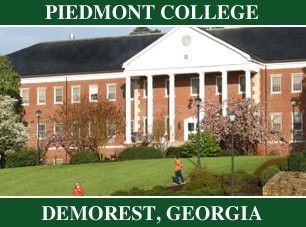"Give Me that Old Time Religion" is the title of the largest show to date at the new Mason-Scharfenstein Museum of Art in Demorest. More than 90 works, including, paintings, sculpture, quilts, and ceramics are included in the show, which represents more than 50 of the Southeast's leading folk artists.
The museum on Georgia Street in downtown Demorest is open from 9 a.m. to 5 p.m., Monday through Saturday. Admission is free. A reception for many of the artists will be held at 6 p.m., June 7 at the museum.
The show is the brainchild of three area folk art enthusiasts, including two Piedmont alumni who several years ago discovered that they had a yen for collecting folk art. Joe Piper of Gainesville, a member of the Class of '95, and Robin Blan of Dawsonville, Class of '00, along with Tracey Burnette of Dawsonville worked with Piedmont Art Department Chair Chris Kelly to stage the exhibit.
Piper said he became interested in folk art when, out of curiosity, he visited R.A. Miller, whose whirligigs and tin work used to festoon his home on Old Highway 441 between Cornelia and Gainesville. Miller had gained national prominence after his artwork was featured in an early music video by the Athens band R.E.M.
"I had seen his work on the side of the road and one day just stopped by and started buying from him," Piper said. That initial purchase sparked an interest in folk art of all kinds. "I enjoy getting to know the artists," Piper said. "Many of them have gone through hard times, or they are supporting family members going through difficult times. Their art allows them to put food on the table."
Eventually Piper said he found his way to a gallery in Dawsonville that specializes in folk art. Called "Around Back at Rocky's Place," this gallery is operated by Blan and Burnette, who both teach; Blan teaches English in Barrow County, and Burnette teaches art in Dawson County.
Blan said she and Burnette had actually met years earlier while attending Gainesville State College. About 20 years ago they bumped into each other while attending a kiln opening and discovered they were both avid collectors of folk art. They soon pooled their interests and opened Rocky's Place, named for Burnette's late, lamented dog.
The three approached then-Piedmont President Ray Cleere, who was enthusiastic about staging a show of folk art at the college, but the project had to wait until the renovations of the existing art museum were complete. The building reopened in October 2011 as the Mason-Scharfenstein Museum of Art.
Not only does the Piedmont exhibit include a large number of artists, several of them are considered the "grandfathers" of Southern folk art, Blan said. In addition to Miller, these include Lanier Meaders, Howard Finster, and Mose Tolliver.
Blan said in her experience interest in folk art has been steady over the past several years, despite downturns in the economy. Many artists' works are still very affordable, particularly for young people who are interested in starting a collection. There is also a wide variety of art available, as the Piedmont exhibit shows.
"Even though folk artists live around the country, a large majority of them call the South home," Blan said. The focus of this presentation at Piedmont is on folk art from the Southern region. The exhibit also presents an area that is very important in the lives of many Southerners-their religion, be it fire and brimstone, or conservative and straight-laced. The exhibit includes pieces depicting Biblical scenes, scripture, churches, and worship services all created from the heart and soul in rich, vibrant, bold colors."
The Devil also "has his day" in folk art, Blan said. "Devils were a mainstay in the work of R.A. Miller, who used the devil as a theme to carry out the word of God," she said. "Face jugs, especially the devil faces, served different purposes. One was as a deterrent for children partaking in 'spirits' or moonshine. Other jugs were placed on the graves of the recently deceased in hopes of warding off the evil spirits, allowing the soul a clear and speedy path to heaven."

http://accesswdun.com/article/2012/5/249011
